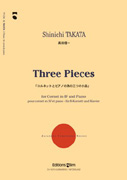Takata, Shinichi Pieces (3)
Trumpet Solos w/Piano

-
Takata, Shinichi
Pieces (3) [cornet]
Shinichi Takata’s Three pieces for Cornet and Piano is the oldest known written score for the cornet ever composed by a Japanese. Shinichi wrote the work in 1939, when he was 18 years old, for Fujio Nakayama (1918-1997), who is regarded as a founder of the Japanese trumpet school. The first performance was given in the same year by Nakayama and Takata. The score, however, languished in complete obscurity until 1999 when it was found at Takata’s residence. Although the composer had a remarkable aptitudefor all aspects of music, the score remained relatively unknown for a number of reasons.Firstly, Takata was generally regarded as a conductor rather than a composer.
Secondly, he died at the early age of 39 years, and finally, and perhaps most significantly, with the exception of Nakayama, the musical and technical demands of the score must have been very difficult for any Japanese player.
The genesis of this particular score lies with the gift of a cornet to Fujio Nakayama by his eldest brother who was living in London. The cornet was manufactured by Salvationist Publishing & Supplies Ltd. Takata became interested in the instrument and studied the Jean-Baptiste Arban’s (1825-1889) Complete Conservatory Method for Trumpet (Cornet) along with Nakayama leading him writing the score.
The score requires advanced techniques such as double/triple tonguing and acciaccatura throughout the movements. At the end of the score, two octave glissando is used with a touch of humor. Such a style must have been quite novel in those days.
The French influence is sprinkled throughout all of the movements in a subtle and natural way as evidenced by the music’s architectonic structure and design, wherein the composer not only included the French harmonic style in his own music, but he also successfully blended it with traditional Japanese harmonic elements.
I found the autographed cornet part in Prof. Fujio Nakayama’s mementos, and as his last pupil it is my great pleasure to introduce this music.
--Osamu Kumashiro
-
- Category: Trumpet Solos w/Piano
- Item: 091614
- Grade/Level:
- Price: $30.45
-
(usually ships in 10 to 15 days)
